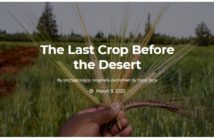The Economist
 Sharp rises in global food prices are causing international concern. The Economist Intelligence Unit believes that a weather-related risk premium is affecting several soft commodity markets, and that prices for a number of major food crops will stay near current highs in the rest of 2012 and in early 2013. However, the latest spike in prices—which caused the World Bank last week to warn of food crises in poor countries—has only limited further implications (for now) for our full-year forecasts.
Sharp rises in global food prices are causing international concern. The Economist Intelligence Unit believes that a weather-related risk premium is affecting several soft commodity markets, and that prices for a number of major food crops will stay near current highs in the rest of 2012 and in early 2013. However, the latest spike in prices—which caused the World Bank last week to warn of food crises in poor countries—has only limited further implications (for now) for our full-year forecasts.
Agricultural producers in countries including the US, Russia, Kazakhstan and Ukraine have been suffering the effects of drought or exceptionally dry weather. This has had a major impact on estimates of crop output and yields for the 2012/13 crop year, which in turn has contributed to sharp price rises. In its August Food Price Watch, the World Bank said that world food prices in July had soared by 10% month on month. Export prices for maize and wheat were up by 25% over the same period, while soybean prices rose by 17%. In contrast, rice prices fell by 4%. The latest market developments were enough for the bank to express concern about the impact of food prices on poverty in developing countries, particularly in Africa and the Middle East and, more generally, in countries that rely heavily on imports of food or in which spending on food accounts for a high share of household income.
The World Bank’s report made headlines, but our own food price forecasts are unlikely to change significantly unless there are further large, sustained rises in prices. In mid-August we revised up our forecasts for some crops and for our overall food, feedstuffs and beverages index. This was largely to account for drought and dry weather in the US (where maize and soybean crops have been hard hit) and eastern Europe (a major wheat producer). The World Bank’s announcement therefore reflects developments that are largely factored into our calculations.
In addition, the fact that prices for wheat, maize and soybeans were much lower in early 2012 will limit the potential for price rises on an average annual basis. For example, we still expect the average price of maize (US No. 3 Yellow Corn, fob Gulf ports) to be just 4.2% higher in 2012 than in 2011—although prices were inflated to begin with following a 51% rise last year. Global maize stocks will remain very tight in the next year. Meanwhile, our wheat price forecast still envisages an average decline of almost 4% this year (based on the export price of US Hard Winter wheat). The bumper crops recorded in the past three years should mitigate some of the pressure on wheat stocks. Although stocks are tightening, and we expect wheat output to fall by about 5% this year, the decline in production will occur from a very high base, which should limit the potential for further price rises.
International concerns about the availability and affordability of food staples are unlikely to dissipate easily. Although we believe grain prices may have peaked, and may even have overshot levels implied by market fundamentals, we may still raise our price forecasts further if the rally persists. Prices should drop slightly in early 2013, but they will remain high.
More positively in terms of food security for developing countries is that rice prices—which shot up dramatically during a previous major bout of global food price inflation in 2008—are bucking the trend. Four years ago, disease and poor weather reduced rice output, particularly in Asia, at a time when stocks were already low. Now, however, inventories are more than ample, and unless production in India proves unexpectedly poor (not our current forecast), shortages in the global market seem unlikely. India’s monsoon has picked up, and the worst-affected dry areas are in the south and west of the country rather than in the north, where the mechanised and more productive rice farming takes place. Thailand’s rather bungled policy efforts to manipulate the global rice market also seem to have backfired, creating a huge stockpile that will eventually create downward pressure on prices instead of supporting the market as the government had hoped. The main caveat is that rice is an extremely thinly traded commodity—only about 7% of all rice produced is traded internationally—and that even small changes in the market can have a disproportionately large global impact.
The broader implications of continuing high global food prices are varied. All else being equal, the situation is potentially inflationary—especially in countries in which spending on food accounts for a relatively large share of consumers’ income. High inflation would be a potentially unwelcome development at a time when most central banks are struggling with weak or slowing economic activity and are either easing monetary policy or maintaining loose monetary policy. A sudden need to tighten policy in response to food-driven inflation could imperil broader efforts to support economic recovery. A further complication is the effect of oil prices, which contribute significantly to food prices through fertiliser and transport costs. Oil prices have not reached the highs they hit either in March this year or in mid-2008, but they have risen sharply since their recent trough in late June. If high prices are sustained for whatever reason—for instance, as a result of geopolitical tensions involving Iran—this would be a bullish factor for food markets.
Risk premium
In conclusion, the outlook going into 2013 remains distinctly uncertain. Depending on demand trends and other factors, prices would be more likely to ease once supply pressures related to recent weather problems disappeared. Moreover, automatic stabilisers are to some degree built into food markets, in that a period of high prices typically encourages farmers to invest and plant more, eventually boosting supply. Offsetting this, however, is that the effects of the recent ultra-dry conditions will linger, negatively affecting prospects for next year’s crops. Indeed, we recently revised up our 2013 food price forecasts for this reason.
Given these varied market forces, further food price volatility of the sort noted by the World Bank would come as no surprise. While our current view is that worries about high prices are overdone given fundamentals, it is also the case that traders are factoring in what is in effect a risk premium similar to that in the oil market (but weather- rather than geopolitics-related). The recent tightness in supply makes food commodity markets more vulnerable to the slightest additional shock on the weather front, which could then lead to “worst case” price scenarios being realised. For example, while we expect a drop in the US soybean crop, prospects for total production look good because we expect strong Latin American production from crops harvested in early 2013. The risk is that Brazil and Argentina account for nearly 50% of global soybean production (compared with about one-third for the US), so if the two countries were also to suffer from unseasonal weather resulting in a lower than expected harvest, then recent price rises would really be justified.
Previous article Next article
EIU forecast—global stimulus betrays concerns over growth
.







